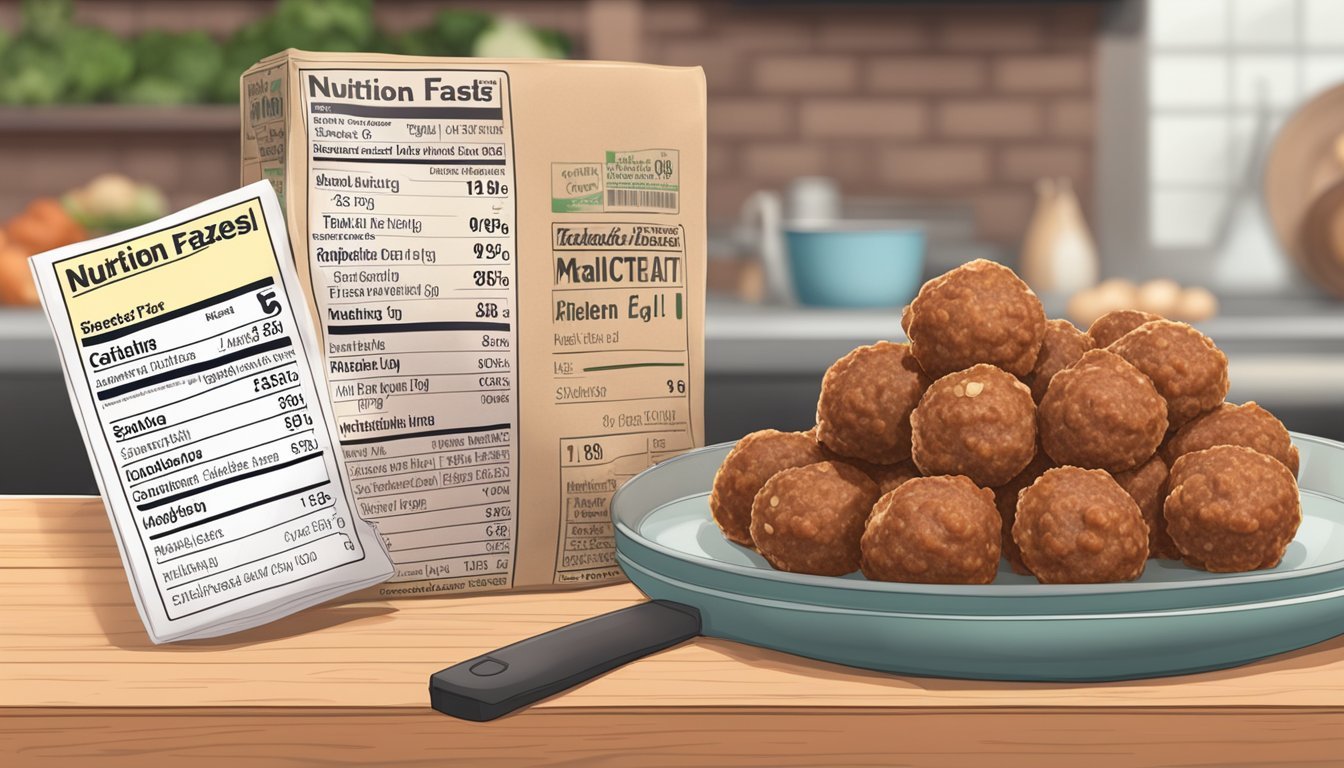Frozen vs Fresh Meatballs: A Savory Showdown
Meatballs are a versatile and beloved food, enjoyed in various cuisines around the world. When it comes to preparing these savory spheres, home cooks often face a choice between frozen and fresh options. While fresh meatballs offer a homemade touch, frozen meatballs provide convenience and consistency that many find appealing.
Frozen meatballs have come a long way in terms of quality and flavor. Many brands now offer products that rival homemade versions, with options ranging from classic Italian-style to more exotic flavors. These pre-made meatballs can be a time-saver for busy households, allowing for quick meal preparation without sacrificing taste.
Fresh meatballs, on the other hand, give cooks more control over ingredients and seasoning. They can be tailored to specific dietary needs or preferences, and often have a superior texture compared to their frozen counterparts. The choice between frozen and fresh ultimately depends on individual priorities, balancing convenience against customization and texture.
Comparison of Frozen vs Fresh Meatballs
Frozen and fresh meatballs each offer distinct advantages in terms of convenience, shelf life, and culinary applications. Their differences impact storage, preparation methods, and overall dining experience.
Defining Fresh and Frozen Meatballs
Fresh meatballs are typically made in-house at grocery stores or butcher shops, using ground meat and seasonings. They contain no preservatives and are meant for immediate consumption. Frozen meatballs are pre-cooked and flash-frozen to maintain quality. They often include additives to extend shelf life.
Fresh meatballs offer a homemade taste and texture. They allow for customization of ingredients and seasonings. Frozen varieties provide consistency and are available in various flavors and styles.
Shelf Life and Convenience Factors
Fresh meatballs have a short shelf life, usually 1-2 days when refrigerated. They require prompt cooking to ensure food safety. Frozen meatballs can last 3-4 months in the freezer, making them a convenient pantry staple.
Frozen meatballs are ready to use, saving time on meal prep. They're ideal for quick dinners or unexpected guests. Fresh meatballs demand more immediate attention but offer the satisfaction of homemade food.
Many grocery stores stock both options, catering to different consumer needs and preferences.
Cooking and Preparation Differences
Fresh meatballs require full cooking from raw state. This allows for better browning and caramelization, enhancing flavor. They often yield a more tender and juicy result when cooked properly.
Frozen meatballs are pre-cooked and only need reheating. This reduces cooking time significantly. They can be added directly to sauces or soups without thawing.
For optimal results with fresh meatballs:
Brown in a skillet before finishing in sauce
Bake in the oven for even cooking
Use a meat thermometer to ensure proper internal temperature
Frozen meatballs are versatile:
Simmer in sauce on stovetop
Heat in microwave for quick appetizers
Add to slow cooker recipes for hands-off meal prep
Both types can produce delicious meals, with the choice depending on time constraints and desired culinary outcomes.
Nutritional Considerations
Frozen and fresh meatballs differ in their nutritional profiles. Key factors include macronutrient content and the presence of additives in frozen varieties.
Macronutrient Content
Protein content varies between frozen and fresh meatballs. Fresh meatballs typically contain 11-16 grams of protein per serving. Frozen options like Teton Waters Ranch offer 11 grams per 3 meatballs.
Calorie counts range from 180-230 per serving for frozen meatballs. Fresh versions may have lower calorie counts, depending on preparation methods.
Saturated fat content is an important consideration. Some frozen brands contain up to 7 grams per serving, while others like Teton Waters have only 1 gram.
Fiber content is generally low in both types, with most containing 0-2 grams per serving.
Presence of Additives and Preservatives
Frozen meatballs often contain preservatives to extend shelf life. Common additives include sodium phosphates and nitrites.
Sodium levels can be high in frozen varieties, ranging from 410-520 mg per serving. Fresh meatballs allow for better sodium control.
Some frozen brands offer organic options with fewer additives. These may use natural preservatives like rosemary extract.
Plant-based frozen meatballs, such as Earth Grown, provide alternatives for those seeking lower saturated fat content.
Checking ingredient lists is crucial for identifying unwanted additives in frozen meatballs. Fresh meatballs allow for complete control over ingredients used.
Ingredient Profiles
Frozen and fresh meatballs differ significantly in their ingredient compositions. The quality of meat, flavorings used, and presence of fillers impact taste, nutrition, and overall quality.
Meat Quality and Sources
Frozen meatballs often contain a blend of beef, pork, and sometimes chicken. Higher-quality options use grass-fed beef or organic meats. Fresh meatballs typically feature single-source meats like 100% beef or pork.
Some frozen varieties rely on lower-grade meat trimmings. Fresh meatballs allow for greater control over meat quality and sourcing.
Lean-to-fat ratios vary between products. An 80/20 mix is common for juicy meatballs, while leaner options may use a 90/10 ratio.
Flavoring Components
Seasonings play a crucial role in meatball flavor profiles. Common ingredients include salt, garlic, onion powder, and various herbs and spices.
Fresh meatballs often incorporate fresh garlic, onions, and herbs. Frozen versions typically use dried alternatives.
Italian-style meatballs may contain oregano, basil, and parmesan cheese. Swedish varieties often include allspice and nutmeg.
Some brands use natural flavor enhancers like yeast extract. Others rely on artificial flavors to boost taste.
Use of Fillers and Allergens
Fillers are more common in frozen meatballs to maintain texture and reduce costs. Common fillers include:
Breadcrumbs
Textured vegetable protein
Soy protein concentrate
These ingredients can be allergens for some consumers. Fresh meatballs often use fewer fillers, if any.
Egg is a common binding agent in both fresh and frozen meatballs. It helps hold ingredients together.
Some brands use gluten-free fillers like rice flour or cornstarch. This caters to those with gluten sensitivities.
Culinary Applications
Frozen and fresh meatballs offer versatility in the kitchen, adapting to various dishes and cooking methods. Their convenience and flavor make them popular choices for quick meals and gourmet creations alike.
Meatballs in Sauces
Meatballs shine when paired with flavorful sauces. Italian-style meatballs simmer perfectly in marinara sauce, absorbing rich tomato flavors. This classic combination forms the base for spaghetti and meatballs, a beloved comfort food.
Swedish meatballs, on the other hand, are traditionally served with a creamy gravy. The sauce's velvety texture complements the meatballs' savory profile. Both frozen and fresh meatballs work well in these sauce-based dishes, though fresh ones may offer a slightly better texture.
For a quick weeknight dinner, frozen meatballs can be heated directly in the sauce. This method infuses them with flavor while saving time. Fresh meatballs may require pre-cooking before adding to the sauce, but they often provide a more tender result.
Incorporating into Soups and Sandwiches
Meatballs add substance and flavor to soups and sandwiches. Italian wedding soup features small meatballs in a light broth with greens and pasta. The meatballs contribute protein and richness to the soup.
Meatball subs are popular sandwiches that showcase these versatile protein balls. Nestled in a roll and covered with melted cheese, meatballs create a satisfying meal. Frozen meatballs work well for quick assembly, while fresh ones can be tailored to specific flavor preferences.
In soups, meatballs can be added near the end of cooking to prevent overcooking. For sandwiches, pre-heating the meatballs ensures they're hot when served.
Creating Diverse Meals
Meatballs lend themselves to creative culinary applications beyond traditional Italian and Swedish dishes. They can be incorporated into stir-fries, used as pizza toppings, or served as appetizers with various dipping sauces.
For a healthier twist, meatballs can be baked instead of fried. This method works well for both frozen and fresh varieties. Baking allows excess fat to drain away while maintaining flavor and texture.
Meatballs also make excellent additions to grain bowls and salads. Their compact size makes portioning easy, and they can be flavored to complement a wide range of cuisines. Fresh meatballs offer more flexibility in seasoning, but frozen options provide convenience for quick meal assembly.
Brand and Product Variations
The frozen meatball market offers diverse options from specialty artisan products to popular supermarket brands. Consumers can choose from a wide range of flavors, sizes, and quality levels to suit their preferences and budgets.
Specialty and Artisan Brands
Whole Foods carries premium frozen meatballs made with high-quality ingredients. These often feature organic or grass-fed meats and unique flavor profiles. Nature's Rancher, sold at Whole Foods, produces antibiotic-free chicken meatballs.
Bell & Evans offers frozen chicken meatballs known for their all-natural ingredients. Artisan brands frequently use traditional recipes and cooking methods to create authentic flavors.
Some specialty brands focus on dietary restrictions, providing gluten-free, keto-friendly, or plant-based options. These products typically come at a higher price point but cater to specific consumer needs.
Supermarket and Store Brands
Major retailers like Target and Aldi have their own frozen meatball lines. These products often provide good value for money while maintaining decent quality. Aldi's store brand meatballs have gained popularity for their affordability and taste.
Cooked Perfect and Rosina are widely available brands found in many supermarkets. They offer various flavors, including Italian-style and homestyle options. Farm Rich produces popular frozen meatballs known for their versatility.
Trader Joe's Italian Style Meatballs consistently rank high in taste tests. They're praised for their flavor and texture. Store brands often compete well with national brands in terms of quality and price, making them a popular choice for budget-conscious shoppers.
Health and Dietary Preferences
Frozen meatballs offer options for various dietary needs and health concerns. Manufacturers have expanded their product lines to cater to different preferences and restrictions.
Plant-Based and Vegan Options
Vegan meatballs provide alternatives for those avoiding animal products. Brands like Earth Grown offer plant-based options with comparable protein content to traditional meatballs.
These products often use ingredients like soy, pea protein, or vegetables to mimic the texture and flavor of meat. Some vegan meatballs contain up to 16 grams of protein per serving.
Plant-based options may have lower saturated fat content compared to meat-based varieties. However, consumers should still check labels for sodium levels, which can be high in processed foods.
Gluten-Free and Allergy-Friendly Choices
Gluten-free meatballs cater to those with celiac disease or gluten sensitivity. Many brands now offer options made without wheat-based fillers or breadcrumbs.
These products often use alternative binders like rice flour or cornstarch. Consumers with allergies should carefully read labels, as some gluten-free options may contain other common allergens.
Brands may also offer meatballs free from dairy, eggs, or soy to accommodate various dietary restrictions. These allergy-friendly choices expand accessibility for those with multiple food sensitivities.
Impact on Heart Health
The effect of frozen meatballs on heart health varies depending on their composition. Traditional beef meatballs can be high in saturated fat, which may impact cardiovascular health if consumed in excess.
Some brands, like Teton Waters Ranch, offer options with lower saturated fat content - as little as 1 gram per serving. Sodium levels in frozen meatballs can range from 400 to 560 mg per serving.
Choosing lean meat or plant-based options can help reduce saturated fat intake. Consumers concerned about heart health should pay attention to portion sizes and pair meatballs with heart-healthy sides like vegetables and whole grains.
Taste and Texture Analysis
Frozen and fresh meatballs offer distinct taste and texture experiences, influenced by their ingredients, preparation methods, and storage. These differences can significantly impact the overall enjoyment of the dish.
Freshness and Texture Influence
Fresh meatballs typically have a more tender, meaty texture compared to their frozen counterparts. The meat's natural moisture is preserved, resulting in a juicier bite. Homemade or freshly prepared meatballs often incorporate breadcrumbs, which help retain moisture and create a softer texture.
Frozen meatballs can sometimes develop a slightly spongy texture due to ice crystal formation during freezing. However, high-quality frozen meatballs, like those from Pineland Farms, can maintain a texture closer to fresh ones.
The cooking method also affects texture. Baking or pan-frying fresh meatballs creates a crisp exterior, while frozen ones may lack this crispy layer when microwaved.
Flavor Profile and Seasoning Impact
Fresh meatballs generally offer a more pronounced meaty flavor, as the ingredients haven't been exposed to freezing temperatures that can dull taste. They allow for customized seasoning, enabling cooks to adjust spices to personal preferences.
Frozen meatballs, especially Italian-style varieties, often come pre-seasoned. This can be convenient but may limit flavor customization. Some brands, like Sam's Choice Premium Angus Meatballs, aim for a premium taste profile but may fall short in flavor intensity.
Cheese, particularly Parmesan, is a common addition that enhances flavor in both fresh and frozen meatballs. Fresh meatballs allow for the incorporation of high-quality, freshly grated cheese, potentially resulting in a more robust flavor.
Well-seasoned frozen meatballs can still deliver satisfying taste, especially when paired with flavorful sauces. However, they may lack the depth of flavor found in freshly prepared versions.
Consumer Perspectives
Consumers have varying opinions on frozen versus fresh meatballs. Taste preferences and convenience factor heavily into purchasing decisions.
Customer Reviews and Preferences
Many shoppers appreciate the convenience of frozen meatballs. They're quick to prepare and have a long shelf life. Some brands receive praise for their flavor and texture. Rao's and Kirkland Signature Italian-Style Meatballs often get positive reviews.
Freshness is a key factor for those who prefer homemade or deli-prepared meatballs. These consumers cite better taste and ingredient control as reasons for their choice. Price can also influence decisions, with frozen options typically being more affordable.
Blind Taste Tests
Several publications have conducted blind taste tests comparing frozen meatball brands. These tests reveal significant quality differences between products. Factors like texture, seasoning, and meat content impact scores.
In one test, Aldi's Bremer Italian Style Meatballs ranked highly for appetizer use. Another comparison found Costco's Kirkland brand performed well against pricier competitors. Taste testers often note that the best frozen meatballs can rival homemade versions in flavor and texture.
Some tests include both frozen and fresh meatballs. Results vary, but top-rated frozen brands frequently compete well with fresh alternatives. These comparisons help consumers make informed choices based on quality and value.
Environmental and Ethical Considerations
The production and consumption of meatballs have significant environmental and ethical implications. These factors influence both frozen and fresh varieties, affecting sustainability and animal welfare.
Sustainability of Meat Sources
Beef production for meatballs contributes substantially to greenhouse gas emissions. Swapping just 5% of beef consumption for plant-based alternatives could save 8 million tons of CO2 equivalents in Germany alone.
Plant-based meatballs offer a more sustainable option. Brands like Earth Grown and Jack & Annie's produce vegan alternatives using ingredients such as jackfruit, reducing the environmental impact associated with meat production.
Organic meatballs can provide a middle ground. They often use sustainably sourced ingredients and have lower environmental impacts compared to conventional meat products.
Ethical Farming and Animal Welfare
Animal welfare is a key concern in meatball production. Ethical farming practices prioritize the humane treatment of animals, ensuring they have access to proper nutrition, space, and care.
Some frozen meatball brands, like Teton Waters Ranch, use beef from high-quality sources. This often indicates better animal welfare standards and more ethical farming practices.
Consumers are increasingly considering ethical aspects when making food choices. The COVID-19 pandemic has further heightened awareness of food production methods and their implications.
Plant-based meatballs eliminate animal welfare concerns entirely. They offer an ethical alternative for those who want to avoid animal products while still enjoying the taste and texture of traditional meatballs.
Preparation and Cooking Tips
Frozen meatballs offer convenience and quick preparation. To cook them, preheat the oven to 350°F (175°C) and place the meatballs on a baking sheet lined with parchment paper.
Bake for 25-30 minutes until they reach an internal temperature of 165°F (74°C). Alternatively, use a slow cooker on high for 2-3 hours.
For stovetop cooking, simmer meatballs in sauce over medium-low heat for about 30 minutes, stirring occasionally. This method infuses them with flavor.
Fresh meatballs require more preparation but allow for customization. Mix ingredients, shape into balls, and cook immediately or freeze for later use.
To freeze raw meatballs, place them on a baking sheet and freeze for 1-2 hours. Transfer to a freezer-safe container and store for up to 3-4 months.
When cooking fresh meatballs, pan-fry over medium heat for 8-10 minutes, turning occasionally. Baking at 400°F (200°C) for 20-25 minutes is another option.
Cooking times:
Frozen (oven): 25-30 minutes
Frozen (slow cooker): 2-3 hours
Fresh (pan-fry): 8-10 minutes
Fresh (oven): 20-25 minutes
Both frozen and fresh meatballs can be easily incorporated into various dishes, from pasta to sandwiches.












